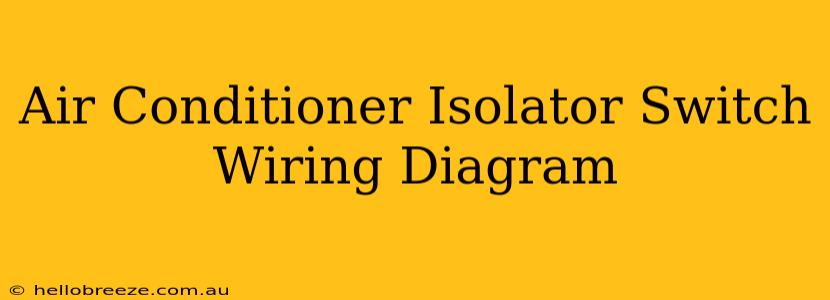An air conditioner isolator switch is a crucial safety device, allowing you to completely disconnect power to your AC unit for maintenance, repairs, or emergencies. Understanding its wiring diagram is essential for safe and effective use. This guide will walk you through different types of wiring diagrams and provide helpful tips for installation and troubleshooting.
Understanding the Components
Before diving into the wiring diagrams, let's familiarize ourselves with the key components involved:
- Air Conditioner (AC) Unit: The main appliance requiring power.
- Isolator Switch: This switch acts as a disconnect, cutting off power to the AC unit. It typically has a visible ON/OFF indicator.
- Power Supply: The source of electrical power, usually a breaker in your electrical panel.
- Wiring: The cables connecting the power supply, the isolator switch, and the AC unit. These often use different colored wires to represent different phases (hot, neutral, ground).
Common Air Conditioner Isolator Switch Wiring Diagrams
The exact wiring diagram will depend on the specific isolator switch and your AC unit's electrical requirements. However, some common configurations exist.
Single-Phase AC Unit Diagram:
This is the most common configuration for residential air conditioners.
Power Supply (Breaker) --> Isolator Switch --> AC Unit
(Hot Wire) (Hot Wire) (Hot Wire)
(Neutral Wire) (Neutral Wire) (Neutral Wire)
(Ground Wire) (Ground Wire) (Ground Wire)
Important Note: Always ensure the ground wire is properly connected for safety.
Three-Phase AC Unit Diagram:
Larger commercial or industrial AC units often operate on three-phase power. The diagram will be more complex, including three hot wires (L1, L2, L3), a neutral wire, and a ground wire.
Power Supply (Breaker) --> Isolator Switch --> AC Unit
(L1) (L1) (L1)
(L2) (L2) (L2)
(L3) (L3) (L3)
(Neutral Wire) (Neutral Wire) (Neutral Wire)
(Ground Wire) (Ground Wire) (Ground Wire)
Caution: Working with three-phase power requires specialized knowledge and should only be performed by qualified electricians.
Troubleshooting Common Issues
If your AC isolator switch isn't functioning correctly, here are some potential issues and troubleshooting steps:
- Switch is not turning on/off: Check the breaker in your electrical panel. Ensure the switch itself isn't faulty. Consider replacing the switch if necessary.
- AC unit still running after switch is turned off: This indicates a wiring problem or a faulty switch. Inspect the wiring connections carefully. A qualified electrician should diagnose and repair this issue.
- Tripping Breaker: This could signal an overload or a short circuit. Check the AC unit for any damage or malfunctioning components. Call a professional for help.
Safety Precautions
Always remember to:
- Turn off the power at the breaker before working with any electrical components.
- Use appropriate safety equipment, including insulated tools and gloves.
- Consult a qualified electrician if you are unsure about any aspect of the wiring or troubleshooting process.
By understanding the wiring diagram of your air conditioner isolator switch and following the safety precautions, you can ensure the safe and reliable operation of your air conditioning system. Remember, safety should always be your top priority when working with electricity.

